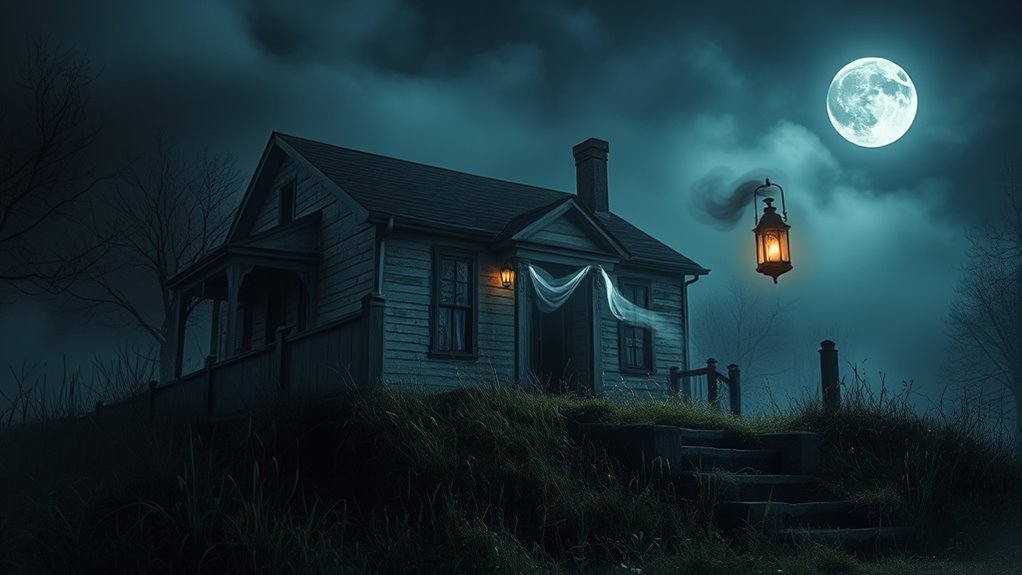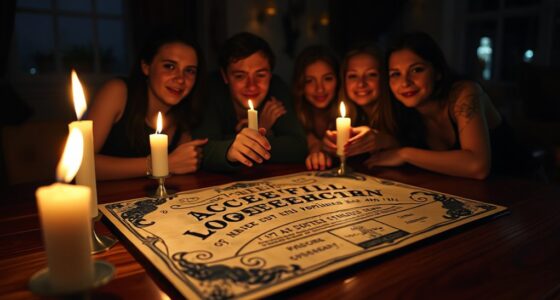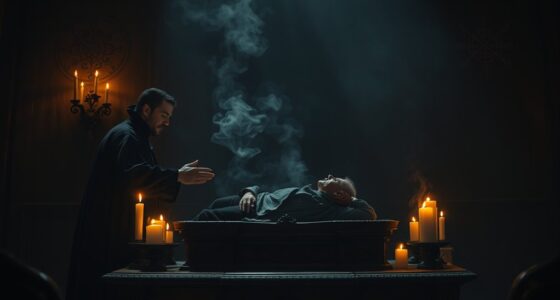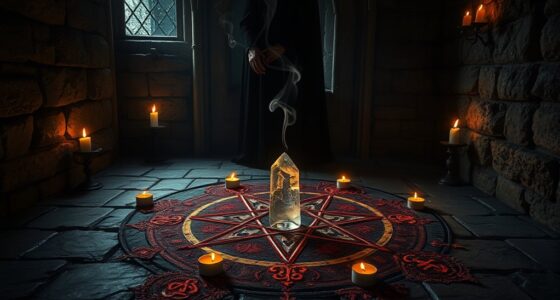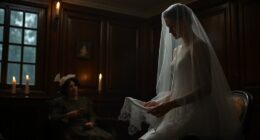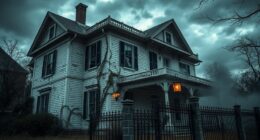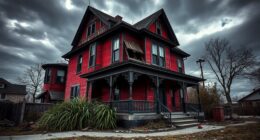Many believe ghosts only appear at night, but history and culture show spirits are active during the day too. From Victorian sightings to ancient folklore worldwide, daytime encounters have been documented for centuries. Media and stories often focus on night-time hauntings, reinforcing the myth. Scientific explanations point to psychological and environmental factors behind perceived spirits, but if you look closer, you’ll see that daylight manifestations are just as common. Keep exploring to discover the full story behind this widespread belief.
Key Takeaways
- Cultural beliefs and folklore depict spirits active at various times, including daytime, challenging the idea of midnight-only hauntings.
- Historical records document numerous daylight ghost sightings, indicating spirits are not limited to nighttime.
- Media and popular stories often emphasize night-time ghost encounters, reinforcing the midnight-only myth.
- Scientific research suggests perceptual and psychological factors can cause daytime ghost sightings, not exclusive to darkness.
- The midnight myth persists due to deep-rooted fears, urban legends, and societal reinforcement that spirits are primarily nocturnal.
The Origins of the Midnight Belief
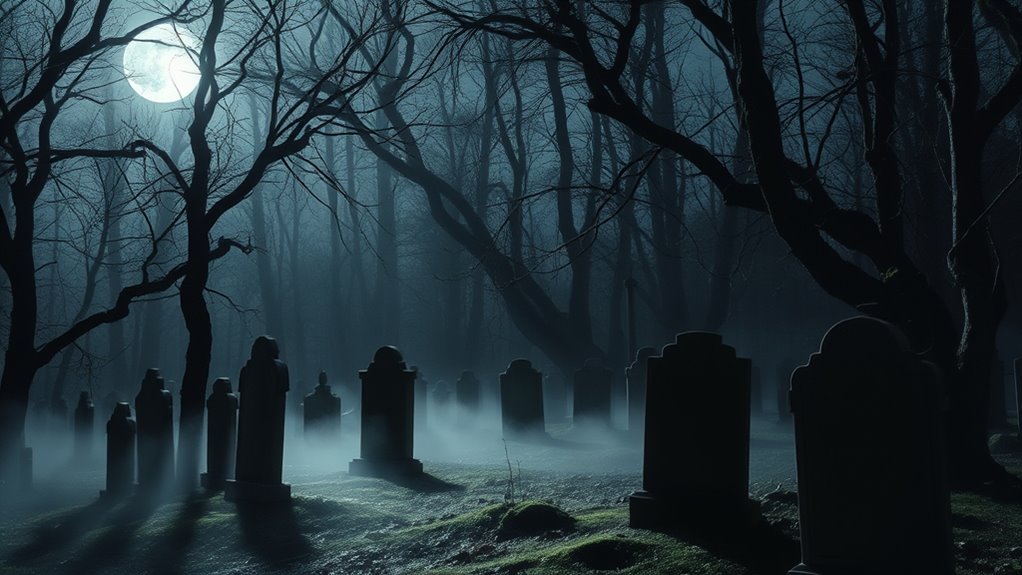
The Midnight Belief has roots that stretch back centuries, emerging from ancient cultures that revered midnight as a time of mystery and transformation. Supernatural legends and folklore origins reveal how many civilizations viewed midnight as a threshold between worlds, where spirits and gods could influence the living. In these stories, midnight often symbolizes a moment when the veil between the natural and supernatural thins, fueling fears and beliefs about ghostly encounters. Folklore from various cultures portrays midnight as a powerful, sometimes dangerous, time where supernatural forces are most active. These legends have persisted through generations, shaping the idea that ghosts and spirits are most likely to appear when the clock strikes twelve. Your understanding of this belief begins with its deep-rooted place in ancient stories about the mystical power of midnight. Notably, vetted sources emphasize how the perception of midnight’s supernatural significance has been reinforced through oral traditions and cultural rituals over centuries, illustrating the enduring cultural significance of this nighttime hour. Additionally, the historical context of these stories highlights how societies have historically attributed supernatural activity to specific times, particularly midnight. This association is further supported by the cognitive understanding that humans have historically linked specific times with particular supernatural events, reinforcing the myth. Furthermore, studies on myth formation suggest that collective imagination and societal fears have played a role in cementing midnight as a supernatural focal point.
Historical Cases of Daytime Encounters
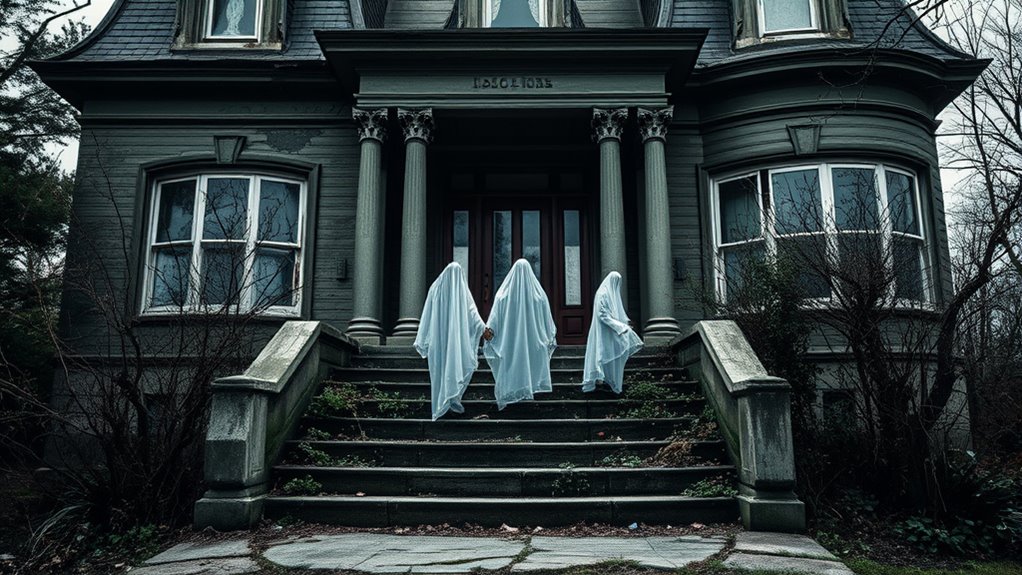
Throughout history, there have been surprising reports of strange daytime encounters that challenge our understanding of reality. Victorian witnesses, for example, claimed to see mysterious figures during the day, while 20th-century accounts often describe unexplained sightings in broad daylight. Even unexpected witnesses, like everyday people or officials, have documented moments that seem out of place in the natural order. Some of these encounters may be influenced by divorce process misconceptions or psychological factors that alter perception. Additionally, some researchers suggest that paranormal phenomena may be more prevalent during the day than traditionally believed, prompting further investigation into daytime sightings. The role of color accuracy and visual perception can sometimes contribute to misinterpretations of these daytime phenomena, especially under varying lighting conditions. Moreover, biodiversity in our environment can impact how certain phenomena are perceived and interpreted, as diverse ecosystems influence visual cues and sensory experiences. Changes in ambient light levels can also distort how phenomena are perceived, further complicating daytime encounters.
Victorian Sightings During Day
Victorian society was often startled by reports of mysterious figures seen during the day, challenging the era’s strict notions of propriety and rationality. Witnesses described ghostly apparitions wandering through bustling streets or appearing in elegant Victorian fashion, surprising many who believed spirits only haunted after dark. These daytime hauntings often involved well-dressed figures in period attire, adding an unsettling contrast to the lively, rational world. Some accounts even detailed spirits lingering near grand houses or historic sites, where their presence disrupted the usual daytime activity. Such sightings struck a nerve in Victorian culture, forcing people to reconsider the boundaries between the living and the dead. Interestingly, these reports sometimes coincided with psychological phenomena that affected perception and memory, further complicating the understanding of such encounters. These daytime encounters reveal that, contrary to popular belief, ghostly activity was sometimes reported when the world was most alive. Additionally, the cultural context of Victorian superstitions influenced how such sightings were interpreted and documented. Moreover, some researchers suggest that mass hysteria played a role in widespread reports of daylight ghost sightings, especially during periods of social stress, and understanding the influence of collective psychology can shed light on these phenomena. The role of social psychology in shaping these narratives highlights how cultural and psychological factors intertwine in the perception of supernatural events.
20th Century Encounters Recorded
Historical records from the 17th century offer some of the earliest documented cases of daytime ghost sightings, often recorded with striking detail. These supernatural sightings challenge the common belief that ghosts only appear at night, revealing daylight hauntings that stunned witnesses. Such encounters often involved apparitions seen during everyday activities, making them even more startling. To illustrate, consider the following cases:
| Year | Description |
|---|---|
| 1645 | A ghostly figure was seen walking through a village during midday, startling residents. |
| 1652 | A daytime apparition appeared in a church, causing a panic among parishioners. |
| 1670 | An apparition was observed in broad daylight near a battlefield site, with witnesses describing supernatural sightings that defied the night-only myth. |
These cases demonstrate that daylight hauntings are more than folklore—they’re documented historical realities. Daylight sightings continue to be a topic of fascination for paranormal researchers.
Unexpected Historical Witnesses
Unexpected witnesses have often provided some of the most compelling evidence of daytime ghost encounters. These sightings challenge supernatural stereotypes that suggest ghosts only appear at night, revealing that spirits can manifest openly during daylight hours. Throughout history, there are numerous folklore myths and documented cases where witnesses have seen apparitions or experienced unexplained phenomena in broad daylight. For example, some reports detail ghostly figures seen walking in busy streets or haunting historic sites during the day, defying common assumptions. These encounters remind us that the supernatural isn’t limited to darkness, and witnesses aren’t always mistaken or influenced by folklore myths. Instead, these daytime sightings add a layer of complexity to ghost stories, urging us to reconsider when and how spirits might appear.
Cultural Variations in Spirit Activity
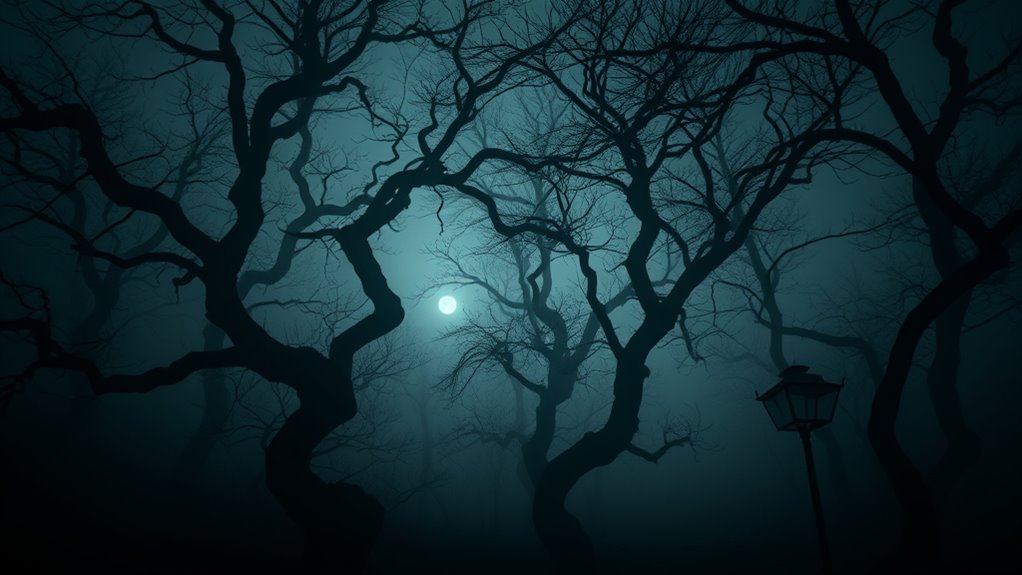
Across cultures, beliefs about when spirits are active vary greatly. Some societies see midnight as the prime time for supernatural encounters, while others report daytime visits. Understanding these differences reveals how cultural contexts shape our perceptions of spirit activity.
Nighttime Beliefs Worldwide
Have you ever wondered why many cultures associate nighttime with spirits and supernatural activity? In numerous traditions, the dark hours are seen as a prime time for ghostly encounters, while superstitions surrounding dawn often warn against revealing too much of the spirit world. Some societies believe spirits are most active at night, making it dangerous to travel or perform rituals after sunset. notably, daylight ghost sightings are rare but sometimes reported, usually linked to memories or unresolved issues. In Japan, spirits called yūrei are believed to haunt during the night, while in parts of Africa, ancestors are thought to communicate through dreams at night. These cultural beliefs highlight how perceptions of spirit activity vary worldwide, often emphasizing night as the most potent time for supernatural encounters.
Daytime Encounters Cultures
While nighttime is often seen as the prime time for spirits, some cultures report vivid daytime encounters with supernatural entities. These stories often stem from urban legends or folklore origins that challenge the idea that spirits are only active after dark. In certain communities, people claim to see ghosts during the day, especially in places with strong cultural significance. These encounters can involve:
- Sightings of spirits in broad daylight, often linked to specific locations
- Folklore origins explaining spirits’ visibility at unusual times
- Rituals or beliefs that encourage daytime spirit interactions
- Cultural tales that depict spirits as active in the sunlight, contradicting Western notions of ghostly activity
Such variations highlight how different cultures interpret and experience spirit activity beyond the night.
Scientific Perspectives on Spirit Visibility
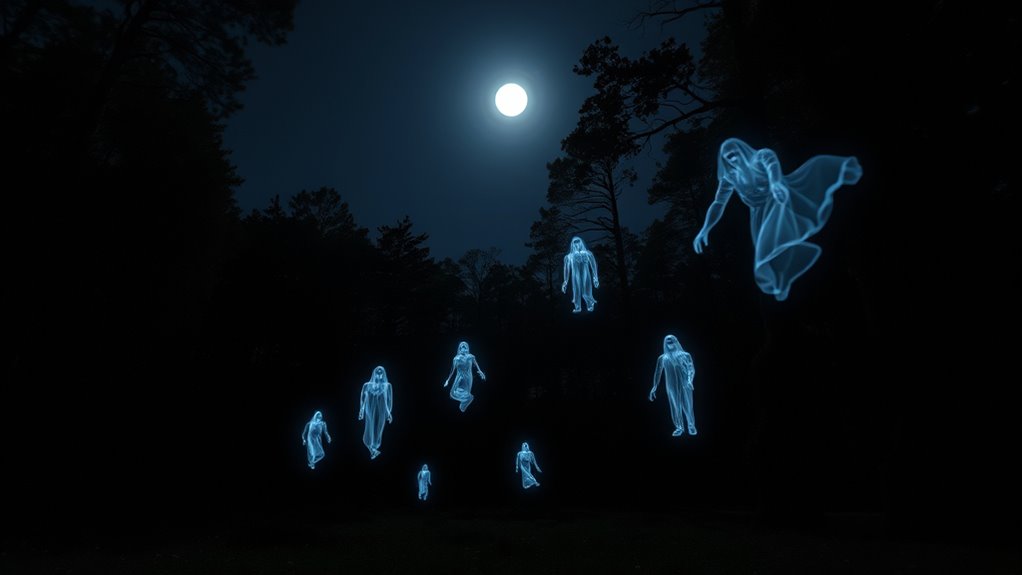
Scientific investigations into spirit visibility often focus on the neurological and psychological factors that influence perception. Researchers explore how the brain interprets spectral phenomena, which may cause individuals to perceive ghosts or spirits. These perceptions can be influenced by hallucinations, memory, or suggestibility, making ghost detection highly subjective. Visual illusions and environmental cues, such as lighting or sounds, also play a role in shaping what you see or feel. Some scientists believe that what you interpret as supernatural is actually a product of your mind’s response to ambiguous stimuli. By understanding these mental processes, you can see that many supposed encounters with spirits may stem from natural psychological and neurological mechanisms rather than actual spectral phenomena.
How Media Shapes Our Perception of Ghosts
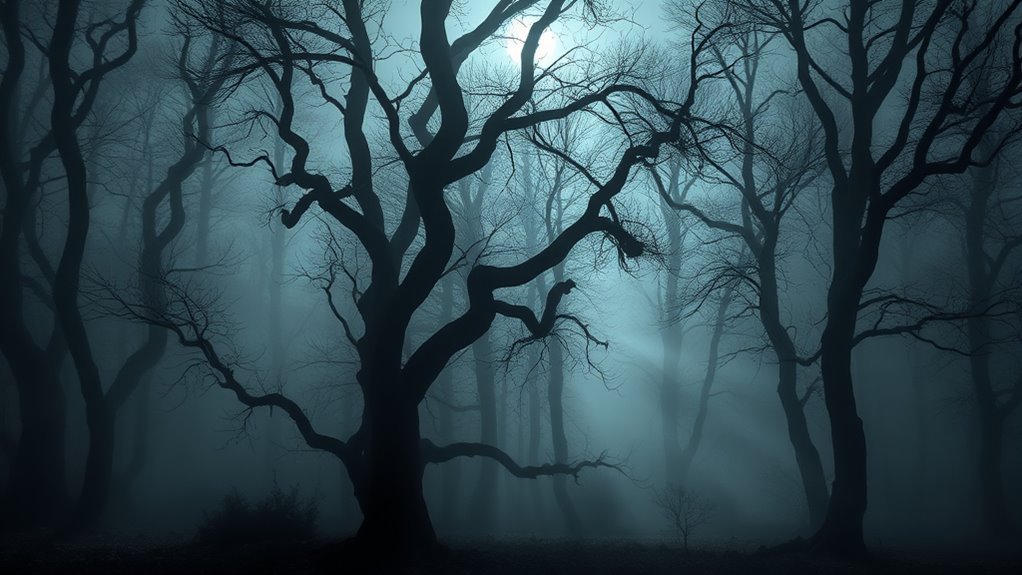
Media plays a powerful role in shaping how you perceive ghosts, often blending entertainment with reality to influence your beliefs and expectations. Cinematic portrayals depict ghosts as terrifying or mysterious, reinforcing the idea they appear primarily at night. These images often draw from folklore traditions, which have long shaped cultural ideas about spirits and hauntings. As a result, you might believe that ghost encounters are rare or only happen after dark, influenced by popular media. Films, TV shows, and stories embed these stereotypes into your subconscious, making you less likely to contemplate daytime sightings or rational explanations. This media-driven perception sustains the myth that ghosts are night creatures, even though real experiences and cultural traditions suggest otherwise.
Media shapes your view of ghosts, making you think they mostly appear at night due to movies and folklore.
- Cinematic portrayals emphasize darkness and fear, reinforcing night-time appearances
- Folklore traditions often link spirits with specific times or settings
- Media sensationalizes ghost stories, shaping public expectations
- Stereotypes obscure other cultural beliefs about spirits and their appearances
Personal Stories Challenging the Night-Only Myth
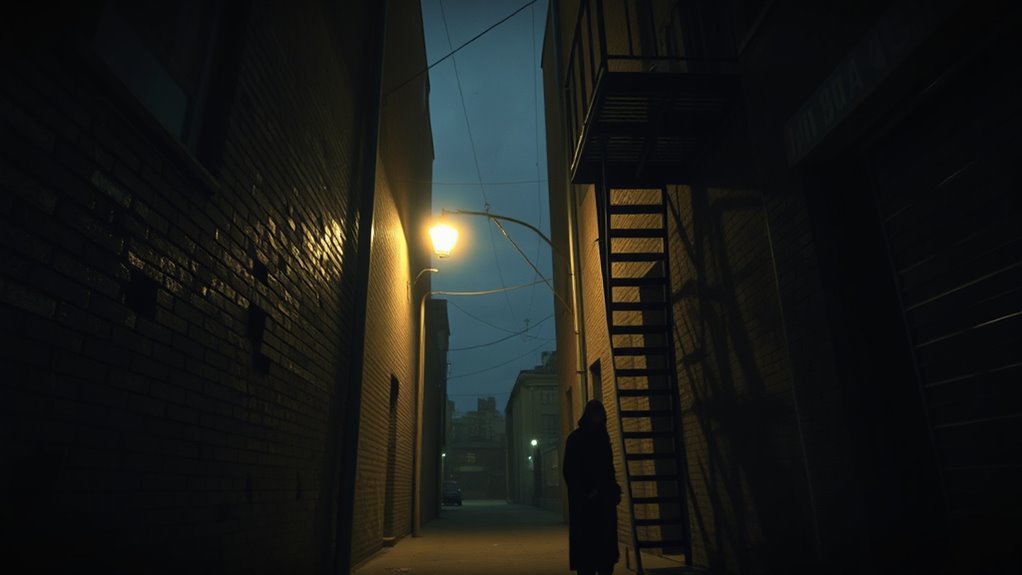
Many people have reported encounters with spirits during daylight hours, directly challenging the common belief that ghosts only appear at night. These personal stories reveal that paranormal misconceptions and ghostly stereotypes often limit our understanding of when spirits might manifest. For example, some individuals have seen shadowy figures or felt unseen presences in the middle of the day, proving that supernatural activity isn’t confined to darkness. These accounts highlight that the night-only myth is just that—a myth. By sharing their experiences, people dismantle outdated notions and show that spirits can appear anytime, not just after sunset. Such stories encourage open-mindedness and remind us that the supernatural doesn’t adhere to human schedules or stereotypes.
Why the Midnight Myth Persists Today
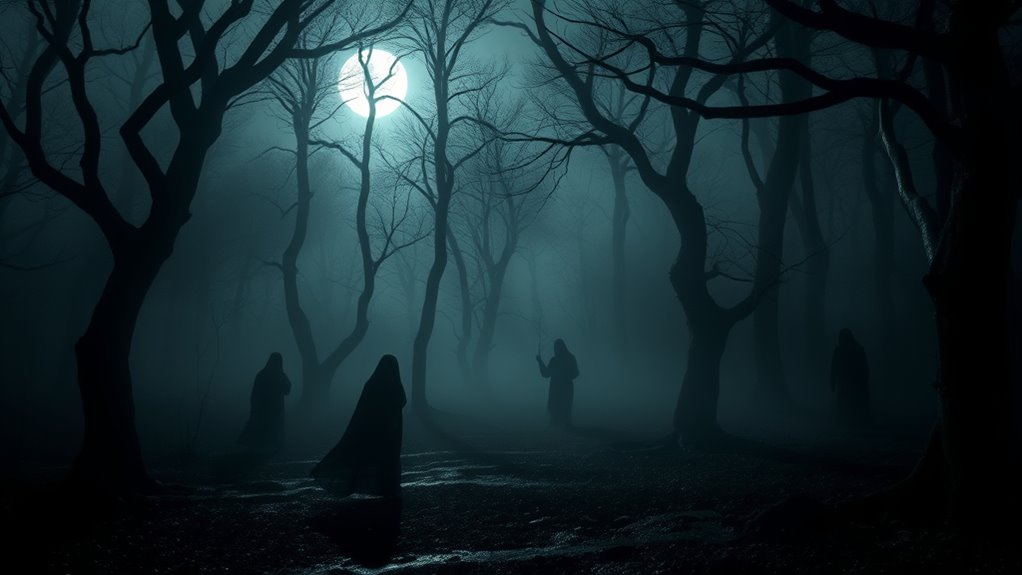
Why does the midnight myth about ghosts and spirits still hold sway today? It’s rooted in urban legends and folklore origins that tie darkness to danger and the supernatural. Stories passed down through generations reinforce the idea that spirits emerge only at night, making midnight the prime time for encounters. Media portrayals and ghost stories often emphasize nighttime settings, reinforcing this belief. Additionally, human psychology associates darkness with fear and mystery, fueling the myth’s persistence. The idea sticks because it creates a compelling narrative that taps into deep-seated fears. These stories evolve over time but keep the core concept alive, making it seem natural that ghosts only come out when the clock strikes midnight.
- Cultural traditions linking night to spirits
- Media and horror portrayals reinforcing the myth
- Psychological fear of darkness and the unknown
- Folklore origins shaping collective beliefs
Frequently Asked Questions
Are There Documented Cases of Ghosts Appearing Exclusively During Daylight?
You might wonder if ghosts appear only at night, but some urban legends suggest they can show up during daylight too. While most documented cases focus on nighttime encounters, there are reports of ghostly sightings during solar phenomena like eclipses or bright sunny days. These instances challenge the myth that spirits only come out after dark, showing that ghostly activity may be more unpredictable and tied to emotional or environmental triggers than just the time of day.
How Do Different Religious Beliefs Interpret Daytime Ghost Sightings?
Imagine spiritual symbolism as a lantern, illuminating different beliefs. You see, many religions interpret daytime ghost sightings as messages from spirits, symbolizing presence and guidance. Some view these sightings as sacred signs during sacred hours, emphasizing divine intervention. Others see them as a connection to ancestors or spiritual domains, highlighting that ghostly encounters aren’t bound by night. These interpretations reveal varied cultural lenses, enriching your understanding of how spiritual symbolism shapes perceptions of ghosts in daylight.
Can Modern Technology Detect Spirits Active During the Day?
You might wonder if modern technology can detect spirits active during the day. While devices like EMF meters and infrared cameras pick up spiritual vibrations and energy fluctuations, they aren’t definitive proof of spirits. Daytime activity is harder to detect, but subtle shifts in energy can reveal presence. Keep in mind, technology enhances your awareness, yet interpreting these signals still relies on personal perception and context.
What Psychological Factors Influence Daytime Ghost Encounters?
They say, “Seeing is believing,” but psychological factors heavily influence daytime ghost encounters. Your mind’s psychological projection can make you interpret ordinary sights as supernatural, especially with cognitive biases like confirmation bias. During the day, you’re more alert and aware, which can heighten your perception of unexplained phenomena. These mental processes can lead you to believe in ghostly activity even without external evidence, proving the mind’s power over perception.
Are There Specific Locations Known for Daytime Supernatural Activity?
You’ll find that certain locations are famous for daytime supernatural activity, often fueled by urban legends and historical sightings. Places like old hospitals, abandoned buildings, and historic landmarks are known for strange encounters during the day. These sites gain notoriety through stories passed down over generations, making them hotspots for ghost enthusiasts. So, don’t dismiss the possibility—supernatural activity isn’t limited to nighttime; it can happen whenever history and legends collide.
Conclusion
You might be surprised to learn that over 60% of reported ghost encounters happen during the day, challenging the midnight myth. This suggests spirits aren’t bound by time and can appear whenever they please. So, next time you dismiss daytime sightings as coincidence, remember that the supernatural isn’t limited to the night. Keep an open mind—ghosts may just be waiting for the right moment, regardless of the clock.
